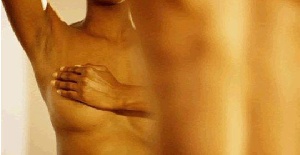Introduction
The breasts, considered as modifications of the glands that produce sweat in the skin, are present in all mammals, of which humans are a vital part. They are present in every mammal- be it male or female, but become more pronounced in females as they mature into puberty. Many diseases can affect the breast and the most perilous of these is breast cancer. Breast cancer still remains a headache in most low- and middle-income countries, with the underlying factor being late detection. According to the World Health Organisation (WHO, 2018), these countries face a double burden of breast and cervical cancer which are the top cancer killers in women over 30 years old and so advocates for early detection. Breast cancer remains the leading cause of cancer deaths in Ghanaian women (Ghana Medical Association, 2012).
Misconceptions
BecTri Consult, a private-owned research company, recently conducted a survey among people in the age group 20-60 years with 80.5% being in the age group 20-30, to find their views and perceptions of breast cancer. 68.5% were females and 31.5% were males. From this survey, 59.7% of them were either reading their first degree or were degree holders, 15.5% were postgraduate students and 2.3% were professionals in their respective fields. According to the survey, 96.9% had heard about breast cancer. The survey involved people from all walks of life and some of their courses/occupations were mathematics and science, nursing, business administration, midwifery, accounting, civil engineering, computer science, biochemistry, B.Ed. Science, Bachelor of Pharmacy, BSc. Electrical and Electronic Engineering, MBA Human Resource, MPhil Human Resource among many others.
The participants aired their opinion on the subject and some of them have been outlined below:
• It is a deadly disease that affects the breasts of only women; I heard wearing too tight brassiere, wearing brassiere to bed and keeping money in the brassieres can cause breast cancer; it presents with a few symptoms making it difficult to detect; when the cancer is not detected early, it becomes malignant; it is becoming prevalent these days; the older one is, the higher the risk; when you are diagnosed with this, you will lose your breasts; there is an abnormal multiplication of the breast cells due to the presence of free radicals; breast cancer can cause one’s breasts to rot; it kills more than ten women a day; I heard it is a bacterial infection that ends up causing pain and swelling of the breasts; I heard that when you massage the breasts and you feel any unfamiliar lump, it could be a breast cancer. These lumps can expand rapidly; the breasts become numb; it is expensive to treat
Facts about Breast Cancer
Breast cancer is a common tumour known in many parts of the world due to its rapidly destructive nature. It is the most common malignant tumour that affects women, constituting about 25% of cancers in females. As at 2012, 1.67 million women were affected worldwide. Of all cancers, breast cancer now forms 11% of them. Breast cancer affects all breasts- be it male breasts or female breasts. The male incidence globally is 1% of all male cancers and 0.6% of all breast cancers worldwide but in Ghana, the male incidence recorded is 2.4%, of all breast cancers. Korle Bu Teaching Hospital, Accra records 400 new cases every year. Out of about 2,260 cumulative cases 1,021 victims have died so far. (Clegg-Lamptey, 2018). The incidence and case fatality rates may even be higher than this, considering the cases that are not reported to the hospital and the victims who are misdiagnosed.
The exact cause of breast cancer still remains a mystery. Some risk factors however have been associated with breast cancer and they include:
• Increasing age
In Ghana, most victims are within the age group 40-49.
• Prolonged exposure to Oestrogen
Some factors that predispose to this include early menses and late menopause, having a first child after age 30, not having any children at all, prolonged use of hormone replacement therapy and combined contraceptives (Archampong et al., 2015).
• Genetic predisposition
In the case where one’s mother or sister has had the disease, there is a 50% chance of having the disease between 20 and 40 years. (Archampong et al, 2015).
• Previously treated breast cancer is associated with a recurrence of the cancer
• Diet: High intake of fat, alcohol, red meat and caffeine is associated with a higher risk (Archampong et al., 2015).
• Exposure to radiation
• Postmenopausal obesity
• Smoking
• A pre-existing cancer of the womb or ovary increases the risk of one getting breast cancer
• Presence of other breast conditions
Breast cancer is indeed a deadly disease, like most cancers, especially when presented in the advanced stage. About 60-70% of the victims in Ghana present very late (6 months or more after they first see signs), when little or nothing can be done about the situation. (Clegg-Lamptey, 2018). The signs to look out for in breast cancer have been discussed subsequently.
Wearing too tight brassieres and the link to breast cancer has been a debate since 1995 when Sydney Singer and Soma Grismaijer wrote their book Dressed to Kill: The Link Between Breast Cancer and Bras.
On one hand, wearing too tight bras impedes the free flow of lymph drainage from the breast, leading to accumulation of toxins in the breast hence increasing the breast cancer risk. On the other hand, Sydney and Soma failed to exclude other factors like family history of breast cancer, diet, exercise habit, and some other risk factors during their research.
The treatment of breast cancer depends on the extent of spread of the tumour. The options for treatment include surgery, radiotherapy, chemotherapy, hormonal therapy and immunotherapy. The choice or combination of treatment depends on the extent of tumour spread at the time of presentation.
Free radicals may damage DNA and cause breast cancer. In breast cancer, the breasts do not necessarily become numb. Rather, the cancer presents as a painless swelling in most cases. The cost of treating breast cancer varies, depending on the presentation. The treatment is tailored to fit individual patients and so is the cost. When breast cancer is detected early and prompt action is taken to curb the growth of the cancer, victims can go on with their normal lives.
Why Breast Cancer Kills A Lot in Ghana: Knowledge and practice of breast self-examination
From the recent survey conducted by BecTri Consult, 96.9% of the participants had heard about breast cancer. Of these, 91.5% had heard about breast self-examination. From the survey, a higher percentage of the participants knew about breast self-examination but do not practise it or practise it seldomly, with some of the reasons being:
• The males thought it was only meant to be done by females
• Some people were not aware of the correct procedure for examining the breasts
• Some do not know what to look out for during the self- examination
• Failure to remember to do it
For the smaller percentage of participants who did it often, it wasn’t done regularly by most of them. An economical, priceless way of detecting breast cancer early is the simple breast self-examination. It is recommended that this is done every month- by both men and women. Women in their reproductive ages can do it at most a week after their period. Men and postmenopausal women can choose a day every month to do it, and it should be done on a regular basis. This link here can be helpful with regards to breast self-examination.
Most people are unaware of the symptoms that accompany this disease and so fail to take the appropriate steps even when these show up.
The signs to look out for while examining the breasts include:
• A breast lump
• Gross differences in the size and symmetry of the breasts
• Changes in the nipple area ( indrawing of the nipples into the breasts, bloody nipple discharge)
• Changes in the skin of breasts (nodular appearance of the breasts, “orange peel” appearance of the breasts, ulcer formation on the breasts)
• Changes in the armpit area like swellings and development of ulcers in the armpit
• Swelling of an arm
• A dimple on the breast
A cardinal feature of breast cancer is a painless swelling so one should not wait for pain if experiencing any of the outlined symptoms before visiting a health centre.
Some symptoms that point to spread of a probable cancer to other organs in the body are breathlessness and cough from spread to the lungs; jaundice (yellowing of the eyes and skin), liver enlargement and abdominal swelling from liver metastasis; headaches, vomiting, unconsciousness and confusion from spread to the brain; bone pain, frequent bone fractures and paralysis from spread to bone. These symptoms indicate that the cancer has advanced and little or nothing could be done aside palliative care. Early detection and appropriate care instituted promptly can prevent metastasis of the cancerous cells to other organs.
Conclusion
Breast cancer is a silent killer-it is painless in its early stages. One should therefore rush to the nearest health center upon detection of any of the aforementioned symptoms. Do not wait for such symptoms to get painful first. Breast cancer, though prevalent in the ages of 40-49, can occur in someone as young as 20 years and in a person as old as 80 years. Most people present in the late stages when little or nothing can be done, hence the call for early detection. Breast cancer is real. Don’t be a victim.
References
• Clegg-Lamptey, J. (2018). Clinical Aspects of Breast Cancer [PowerPoint slides].
• Archampong, E.Q., Naaeder, S., Ugwu, B.T. (2015). BAJA’s Principles and Practice of Surgery.
• World Health Organisation 2018, accessed 13 September 2018, http://www.who.int/cancer/detection/breastcancer/en/
Authored By:
Tricia Bemah Adomako
University Of Ghana School Of Medicine And Dentistry
Contact: 0543228183/tadomako1995@gmail.com
Opinions of Friday, 14 June 2019
Columnist: Tricia Bemah Adomako



















